Web of Science Scientometrics on the Energy Efficiency of Buildings to Support Sustainable Construction Policies
Abstract
1. Introduction
- To identify bibliographic resources in the published scientific literature in the field of energy efficiency and analyze the impact of already published data on the topic, classified according to Web of Science (WoS) domains;
- To contribute in a new and unique way to revealing the importance of this field by centralizing the most prolific journals, collaborative networks, publications etc.;
- To highlight and rank the most prolific/important authors, journals, and countries by time intervals to better assess scientific trends;
- To open up new possibilities for collaboration between authors;
- To provide a conceptual overview of the research topics and practical approaches for future authors to target different journals, topics, publications, and collaborative networks;
- To highlight the most frequently cited articles so that the most significant data can be retrieved more rapidly and precisely;
- To demonstrate the rapidly rising interest in energy efficiency;
- To provide time-saving tools for researchers interested in the topic by performing a visualization and bibliometric analysis of the available research on renewable energy.
2. Materials and Methods
2.1. Web of Science Search and Filter Algorithm
2.2. Algorithm Analysis and Explanatory Detailing of Graphical Elements
3. Results
3.1. Period 1978–2010
3.1.1. Evaluation of the Most Productive Countries in the Field
3.1.2. Assessment of the Most Prolific Journals in the Field
3.1.3. Citation Analysis of Publications in the Evaluated Period
3.1.4. Bibliometric Analysis of the Most Active Organizations in the Field
Most Prolific Research Areas
3.2. Science Mapping Analysis Tools
3.2.1. Country Co-Authorship Assessments
3.2.2. Source Average Publication Year and the Citation Network Map
3.2.3. Term Map and Network Map of Term Co-Occurrence
- “energy efficiency” with “performance”, “energy policy”, “renewable energy”, “performance”, “buildings” and “consumption”;
- “policy” with “energy”, “efficiency”, “consumption”, “conservation” and “renewable energy”;
- “renewable energy” with “power”, “sustainable development”, and “energy policy”.
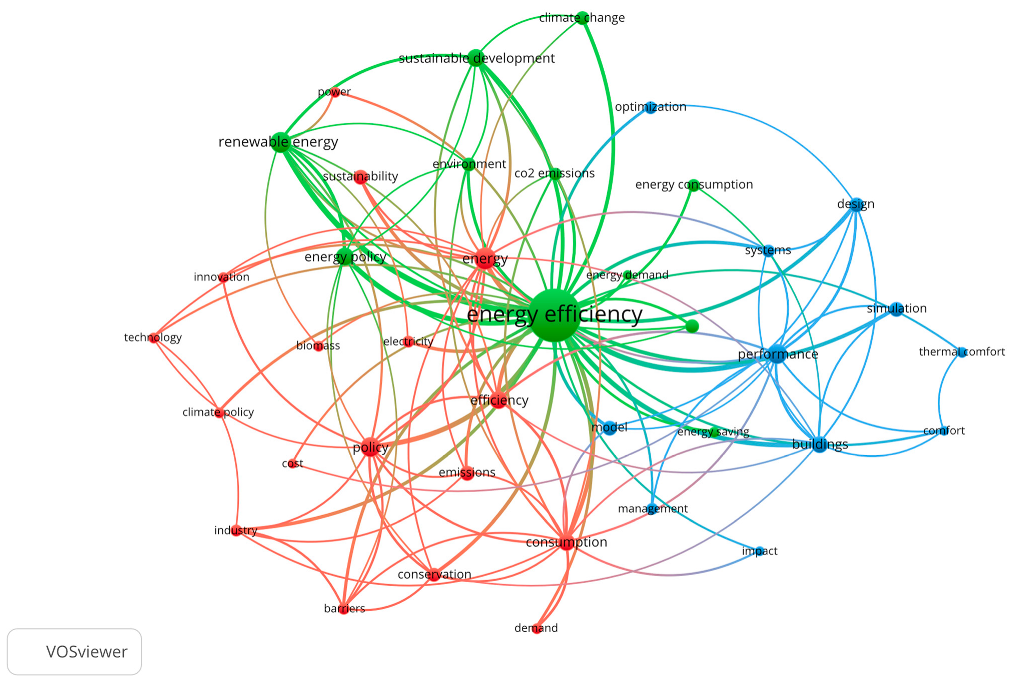
3.3. Period 2011–2023
3.3.1. Evaluation of the Most Productive Countries in the Field
3.3.2. Assessment of the Most Prolific Journals in the Field
3.3.3. Citation Analysis of Publications in the Evaluated Period
3.3.4. Bibliometric Analysis of the Most Active Organizations in the Field
3.4. Science Mapping Analysis Tools
3.4.1. Country Co-Authorship Assessments
3.4.2. Source Average Publication Year and the Citation Network Map
3.4.3. Term Map and Network Map of Term Co-Occurrence
- -
- “energy efficiency with “performance”, “consumption”, “buildings”, “design”, “optimization” and “impact”;
- -
- “performance” with “consumption”, “simulation”, “buildings”, “design”, “thermal comfort” and “optimization”;
- -
- “optimization” with “renewable energy”, “thermal comfort”, “residential buildings”, and “buildings”.
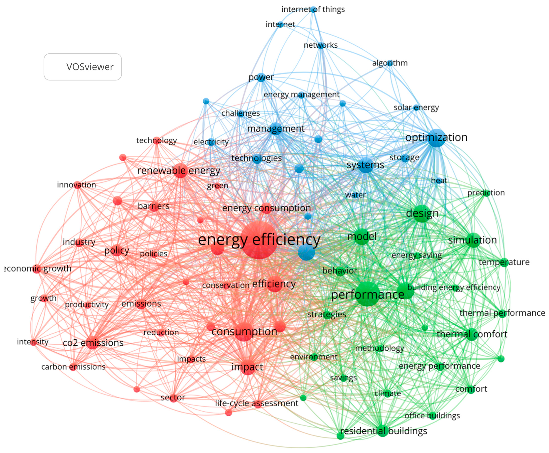
4. Discussion
5. Conclusions
Author Contributions
Funding
Data Availability Statement
Conflicts of Interest
References
- Butera, F.M. Climatic change and the built environment. Adv. Build. Energy Res. 2011, 4, 45–75. [Google Scholar] [CrossRef]
- Bungău, C.C.; Prada, I.F.; Prada, M.; Bungău, C. Design and Operation of Constructions: A Healthy Living Environment-Parametric Studies and New Solutions. Sustainability 2019, 11, 6824. [Google Scholar] [CrossRef]
- Prada, M.; Popescu, D.E.; Bungau, C.; Pancu, R. Parametric Studies on European 20-20-20 Energy Policy Targets in University Environment. J. Environ. Prot. Ecol. 2017, 18, 1146–1157. [Google Scholar]
- Wang, W.; Zmeureanu, R.; Rivard, H. Applying multi-objective genetic algorithms in green building design optimization. Build. Environ. 2005, 40, 1512–1525. [Google Scholar] [CrossRef]
- Prada, M.; Prada, I.F.; Cristea, M.; Popescu, D.E.; Bungău, C.; Aleya, L.; Bungău, C.C. New solutions to reduce greenhouse gas emissions through energy efficiency of buildings of special importance—Hospitals. Sci. Total Environ. 2020, 718, 137446. [Google Scholar] [CrossRef]
- Energy Roadmap. 2050. Available online: https://ec.europa.eu/energy/sites/ener/files/documents/2012_energy_roadmap_2050_en_0.pdf (accessed on 13 February 2023).
- Prada, M.; Popescu, D.; Bungau, C. Building Education, Source of Energy Saving in Romania. In Proceedings of the 15th National Technical-Scientific Conference on Modern Technologies for the 3rd Millennium, Oradea, Romania, 27–28 November 2015; pp. 157–162. [Google Scholar]
- Herman, G.V.; Caciora, T.; Ilies, D.C.; Ilies, A.; Deac, A.; Sturza, A.; Sonko, S.M.; Suba, N.S.; Nistor, S. 3D Modeling of the Cultural Heritage: Between Opportunity and Necessity. J. Appl. Eng. Sci. 2020, 10, 27–30. [Google Scholar] [CrossRef]
- Bungau, C.C.; Bungau, T.; Prada, M.F.; Prada, I.F.; Moleriu, R.D. Sustainable development through green buildings: Updated bibliometric analysis of the literature in the field. Rom. J. Mater. 2023, 53, 82–93. [Google Scholar]
- Hernandez, P.; Kenny, P. From net energy to zero energy buildings: Defining life cycle zero energy buildings (LC-ZEB). Energy Build. 2010, 42, 815–821. [Google Scholar] [CrossRef]
- Kapsalaki, M.; Leal, V.; Santamouris, M. A methodology for economic efficient design of Net Zero Energy Buildings. Energy Build. 2012, 55, 765–778. [Google Scholar] [CrossRef]
- Caballero, V.; Vernet, D.; Zaballos, A. A Heuristic to Create Prosumer Community Groups in the Social Internet of Energy. Sensors 2020, 20, 3704. [Google Scholar] [CrossRef]
- Bhutta, F.M. Application of smart energy technologies in building sector—Future prospects. In Proceedings of the International Conference on Energy Conservation and Efficiency (ICECE), Lahore, Pakistan, 22–23 November 2017; Institute of Electrical and Electronics Engineers Inc.: Piscataway, NJ, USA, 2017; pp. 7–10. [Google Scholar]
- Popescu, D.E.; Bungau, C.; Prada, M.; Domuta, C.; Bungau, S.; Tit, D.M. Waste management strategy at a public university in smart city context. J. Environ. Prot. Ecol. 2016, 17, 1011–1020. [Google Scholar]
- Iwaro, J.; Mwasha, A. The impact of sustainable building envelope design on building sustainability using Integrated Performance Model. Int. J. Sustain. Built Environ. 2013, 2, 153–171. [Google Scholar] [CrossRef]
- Mwasha, A.; Williams, R.G.; Iwaro, J. Modeling the performance of residential building envelope: The role of sustainable energy performance indicators. Energy Build. 2011, 43, 2108–2117. [Google Scholar] [CrossRef]
- Owusu, P.A.; Asumadu-Sarkodie, S. A review of renewable energy sources, sustainability issues and climate change mitigation. Cogent Eng. 2016, 3, 1167990. [Google Scholar] [CrossRef]
- Panwar, N.L.; Kaushik, S.C.; Kothari, S. Solar greenhouse an option for renewable and sustainable farming. Renew. Sustain. Energy Rev. 2011, 15, 3934–3945. [Google Scholar] [CrossRef]
- Tiwari, G.N.; Mishra, R.K. Advanced Renewable Energy Sources; Royal Society of Chemistry: London, UK, 2012. [Google Scholar]
- Methodology for Calculating the Energy Performance of Buildings. Part I-Building Envelope. Code Mc 001/1-2006. Available online: https://www.mdlpa.ro/userfiles/reglementari/Domeniul_XXVII/27_11_MC_001_1_2_3_2006.pdf (accessed on 14 February 2023).
- Minarčík, P.; Procházka, H.; Gulan, M. Advanced Supervision of Smart Buildings Using a Novel Open-Source Control Platform. Sensors 2020, 21, 160. [Google Scholar] [CrossRef]
- Shahi, S.; Esnaashary Esfahani, M.; Bachmann, C.; Haas, C. A definition framework for building adaptation projects. Sustain. Cities Soc. 2020, 63, 102345. [Google Scholar] [CrossRef]
- Asdrubali, F.; Baldassarri, C.; Fthenakis, V. Life cycle analysis in the construction sector: Guiding the optimization of conventional Italian buildings. Energy Build. 2013, 64, 73–89. [Google Scholar] [CrossRef]
- Simpeh, E.K.; Pillay, J.P.G.; Ndihokubwayo, R.; Nalumu, D.J. Improving energy efficiency of HVAC systems in buildings: A review of best practices. Int. J. Build. Pathol. Adapt. 2022, 40, 165–182. [Google Scholar] [CrossRef]
- Al-Ghaili, A.M.; Kasim, H.; Al-Hada, N.M.; Othman, M.; Saleh, M.A. A Review: Buildings Energy Savings—Lighting Systems Performance. IEEE Access 2020, 8, 76108–76119. [Google Scholar] [CrossRef]
- Sailor, D.J.; Anand, J.; King, R.R. Photovoltaics in the built environment: A critical review. Energy Build. 2021, 253, 111479. [Google Scholar] [CrossRef]
- Schweiker, M. Understanding Occupants’ Behaviour for Energy Efficiency in Buildings. Curr. Sustain. Energy Rep. 2017, 4, 8–14. [Google Scholar] [CrossRef]
- Bungau, C.C.; Bungau, C.; Toadere, M.T.; Prada-Hanga, I.F.; Bungau, T.; Popescu, D.E.; Prada, M.F. Solutions for an Ecological and Healthy Retrofitting of Buildings on the Campus of the University of Oradea, Romania, Built Starting from 1911 to 1913. Sustainability 2023, 15, 6541. [Google Scholar] [CrossRef]
- Van Eck, N.J.; Waltman, L. Software survey: VOSviewer, a computer program for bibliometric mapping. Scientometrics 2010, 84, 523–538. [Google Scholar] [CrossRef] [PubMed]
- Pérez-Lombard, L.; Ortiz, J.; Pout, C. A review on buildings energy consumption information. Energy Build. 2008, 40, 394–398. [Google Scholar] [CrossRef]
- Ibrahim, H.; Ilinca, A.; Perron, J. Energy storage systems—Characteristics and comparisons. Renew. Sustain. Energy Rev. 2008, 12, 1221–1250. [Google Scholar] [CrossRef]
- Granqvist, C.G. Transparent conductors as solar energy materials: A panoramic review. Sol. Energy Mater. Sol. Cells 2007, 91, 1529–1598. [Google Scholar] [CrossRef]
- Swan, L.G.; Ugursal, V.I. Modeling of end-use energy consumption in the residential sector: A review of modeling techniques. Renew. Sustain. Energy Rev. 2009, 13, 1819–1835. [Google Scholar] [CrossRef]
- Greening, L.A.; Greene, D.L.; Difiglio, C. Energy efficiency and consumption—The rebound effect—A survey. Energy Policy 2000, 28, 389–401. [Google Scholar] [CrossRef]
- Song, C. Fuel processing for low-temperature and high-temperature fuel cells: Challenges, and opportunities for sustainable development in the 21st century. Catal. Today 2002, 77, 17–49. [Google Scholar] [CrossRef]
- Jones, A.P. Indoor air quality and health. Atmos. Environ. 1999, 33, 4535–4564. [Google Scholar] [CrossRef]
- Omer, A.M. Energy, environment and sustainable development. Renew. Sustain. Energy Rev. 2008, 12, 2265–2300. [Google Scholar] [CrossRef]
- Yu, W.; France, D.M.; Routbort, J.L.; Choi, S.U.S. Review and comparison of nanofluid thermal conductivity and heat transfer enhancements. Heat Transf. Eng. 2008, 29, 432–460. [Google Scholar] [CrossRef]
- Dietz, T.; Gardner, G.T.; Gilligan, J.; Stern, P.C.; Vandenbergh, M.P. Household actions can provide a behavioral wedge to rapidly reduce US carbon emissions. Proc. Natl. Acad. Sci. USA 2009, 106, 18452–18456. [Google Scholar] [CrossRef]
- Yang, Z.; Zhang, J.; Kintner-Meyer, M.C.W.; Lu, X.; Choi, D.; Lemmon, J.P.; Liu, J. Electrochemical energy storage for green grid. Chem. Rev. 2011, 111, 3577–3613. [Google Scholar] [CrossRef]
- Luo, X.; Wang, J.; Dooner, M.; Clarke, J. Overview of current development in electrical energy storage technologies and the application potential in power system operation. Appl. Energy 2015, 137, 511–536. [Google Scholar] [CrossRef]
- Palensky, P.; Dietrich, D. Demand side management: Demand response, intelligent energy systems, and smart loads. IEEE Trans. Ind. Inform. 2011, 7, 381–388. [Google Scholar] [CrossRef]
- Bocken, N.M.P.; Short, S.W.; Rana, P.; Evans, S. A literature and practice review to develop sustainable business model archetypes. J. Clean. Prod. 2014, 65, 42–56. [Google Scholar] [CrossRef]
- Raman, A.P.; Anoma, M.A.; Zhu, L.; Rephaeli, E.; Fan, S. Passive radiative cooling below ambient air temperature under direct sunlight. Nature 2014, 515, 540–544. [Google Scholar] [CrossRef]
- Gielen, D.; Boshell, F.; Saygin, D.; Bazilian, M.D.; Wagner, N.; Gorini, R. The role of renewable energy in the global energy transformation. Energy Strategy Rev. 2019, 24, 38–50. [Google Scholar] [CrossRef]
- Dincer, I.; Acar, C. Review and evaluation of hydrogen production methods for better sustainability. Int. J. Hydrog. Energy 2015, 40, 11094–11111. [Google Scholar] [CrossRef]
- Cabeza, L.F.; Castell, A.; Barreneche, C.; De Gracia, A.; Fernández, A.I. Materials used as PCM in thermal energy storage in buildings: A review. Renew. Sustain. Energy Rev. 2011, 15, 1675–1695. [Google Scholar] [CrossRef]
- Di Renzo, M.; Haas, H.; Ghrayeb, A.; Sugiura, S.; Hanzo, L. Spatial modulation for generalized MIMO: Challenges, opportunities, and implementation. Proc. IEEE 2014, 102, 56–103. [Google Scholar] [CrossRef]
- Wicklein, B.; Kocjan, A.; Salazar-Alvarez, G.; Carosio, F.; Camino, G.; Antonietti, M.; Bergström, L. Thermally insulating and fire-retardant lightweight anisotropic foams based on nanocellulose and graphene oxide. Nat. Nanotechnol. 2014, 10, 277–283. [Google Scholar] [CrossRef]
- Akadiri, P.O.; Chinyio, E.A.; Olomolaiye, P.O. Design of A Sustainable Building: A Conceptual Framework for Implementing Sustainability in the Building Sector. Buildings 2012, 2, 126–152. [Google Scholar] [CrossRef]
- Di Foggia, G. Energy efficiency measures in buildings for achieving sustainable development goals. Heliyon 2018, 4, e00953. [Google Scholar] [CrossRef]
- Hanga-Farcas, I.F.; Bungau, C.C.; Scurt, A.A.; Cristea, M.; Prada, M. The building certification system—A tool of sustainable development of university campuses. J. Appl. Eng. Sci. 2023, 13, 105–112. [Google Scholar]
- Law No. 101 of 1 July 2020 Amending and Supplementing Law No 372/2005 on Energy Performance of Buildings. Available online: https://legislatie.just.ro/Public/DetaliiDocumentAfis/227538 (accessed on 15 February 2023).
- Law No. 372 of 13 December 2005 (*Republished*) on the Energy Performance of Buildings. Available online: https://legislatie.just.ro/Public/DetaliiDocument/66970 (accessed on 16 February 2023).
- Evans, M.; Roshchanka, V.; Graham, P. An international survey of building energy codes and their implementation. J. Clean. Prod. 2017, 158, 382–389. [Google Scholar] [CrossRef]
- Qadir, S.A.; Al-Motairi, H.; Tahir, F.; Al-Fagih, L. Incentives and strategies for financing the renewable energy transition: A review. Energy Rep. 2021, 7, 3590–3606. [Google Scholar] [CrossRef]
- Grzegorzewska, M.; Kirschke, P. The Impact of Certification Systems for Architectural Solutions in Green Office Buildings in the Perspective of Occupant Well-Being. Buildings 2021, 11, 659. [Google Scholar] [CrossRef]
- Belli, L.; Cilfone, A.; Davoli, L.; Ferrari, G.; Adorni, P.; Di Nocera, F.; Dall’Olio, A.; Pellegrini, C.; Mordacci, M.; Bertolotti, E. IoT-Enabled Smart Sustainable Cities: Challenges and Approaches. Smart Cities 2020, 3, 1039–1071. [Google Scholar] [CrossRef]
- Bellini, P.; Nesi, P.; Pantaleo, G. IoT-Enabled Smart Cities: A Review of Concepts, Frameworks and Key Technologies. Appl. Sci. 2022, 12, 1607. [Google Scholar] [CrossRef]
- Sankaran, V.; Chopra, A. Creating Global Sustainable Smart Cities (A Case Study of Masdar City). J. Phys. Conf. Ser. 2020, 1706, 012141. [Google Scholar] [CrossRef]
- Calvillo, C.F.; Sánchez-Miralles, A.; Villar, J. Energy management and planning in smart cities. Renew. Sustain. Energy Rev. 2016, 55, 273–287. [Google Scholar] [CrossRef]
- Almihat, M.G.M.; Kahn, M.T.E.; Aboalez, K.; Almaktoof, A.M. Energy and Sustainable Development in Smart Cities: An Overview. Smart Cities 2022, 5, 1389–1408. [Google Scholar] [CrossRef]
- Kolokotsa, D.; Kampelis, N.; Mavrigiannaki, A.; Gentilozzi, M.; Paredes, F.; Montagnino, F.; Venezia, L. On the integration of the energy storage in smart grids: Technologies and applications. Energy Storage 2019, 1, e50. [Google Scholar] [CrossRef]
- Thynell, M.; Mohan, D.; Tiwari, G. Sustainable transport and the modernisation of urban transport in Delhi and Stockholm. Cities 2010, 27, 421–429. [Google Scholar] [CrossRef]
- Cavada, M.; Tight, M.R.; Rogers, C.D.F. A smart city case study of Singapore—Is Singapore truly smart? In Smart City Emergence. Cases from Around the World; Anthopoulos, L., Ed.; Elsevier: Amsterdam, The Netherlands, 2019; pp. 295–314. ISBN 978-0-12-816169-2. [Google Scholar]
- Bakıcı, T.; Almirall, E.; Wareham, J. A Smart City Initiative: The Case of Barcelona. J. Knowl. Econ. 2013, 4, 135–148. [Google Scholar] [CrossRef]
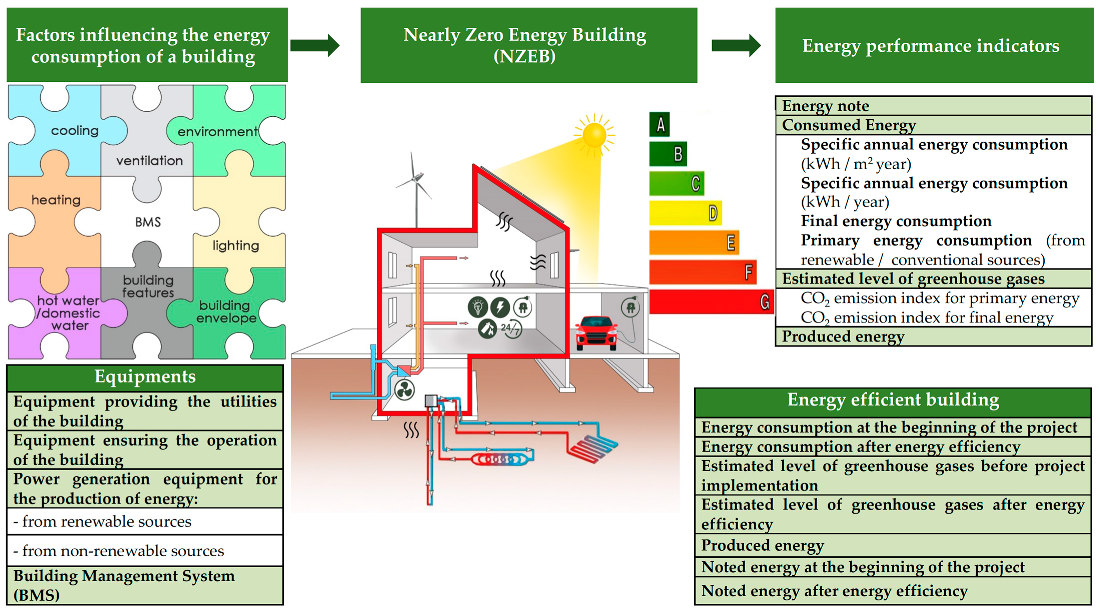
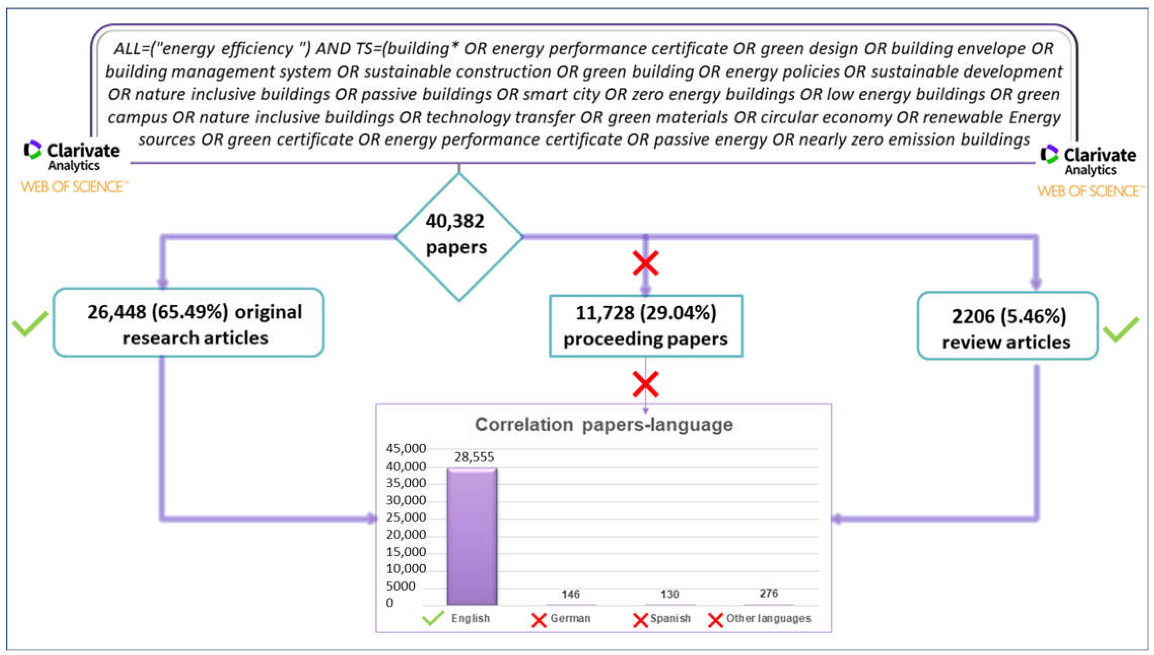
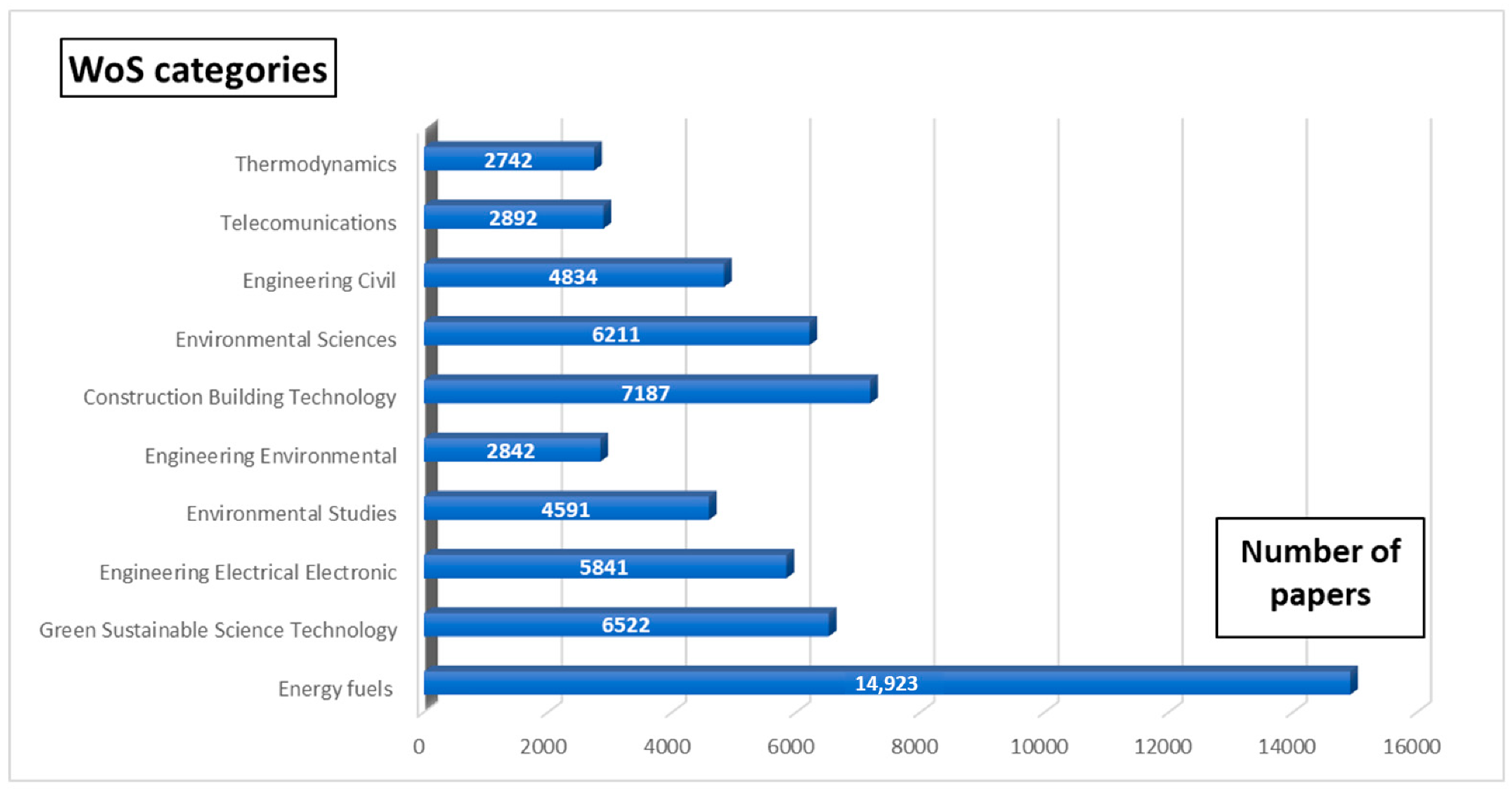
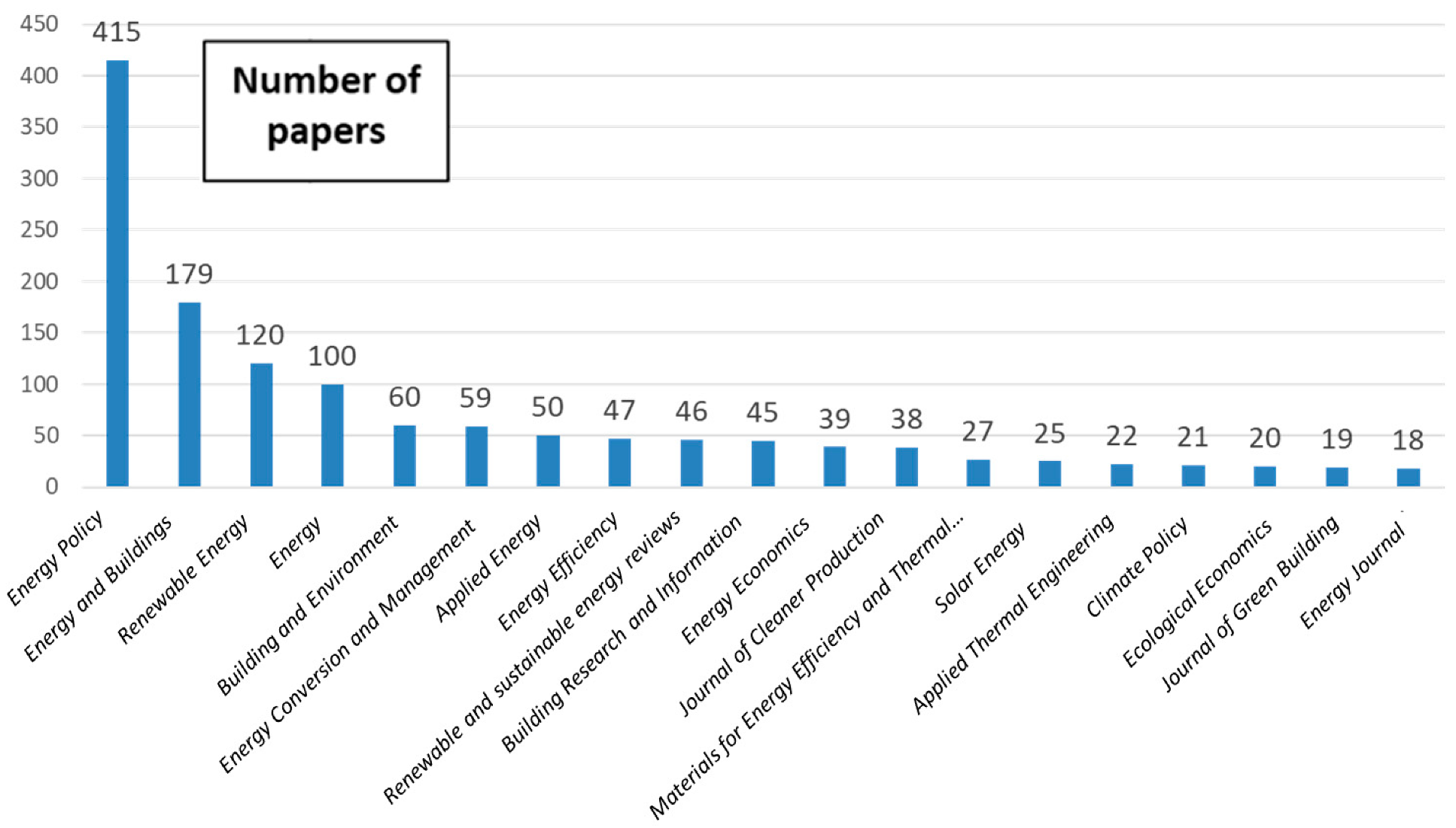
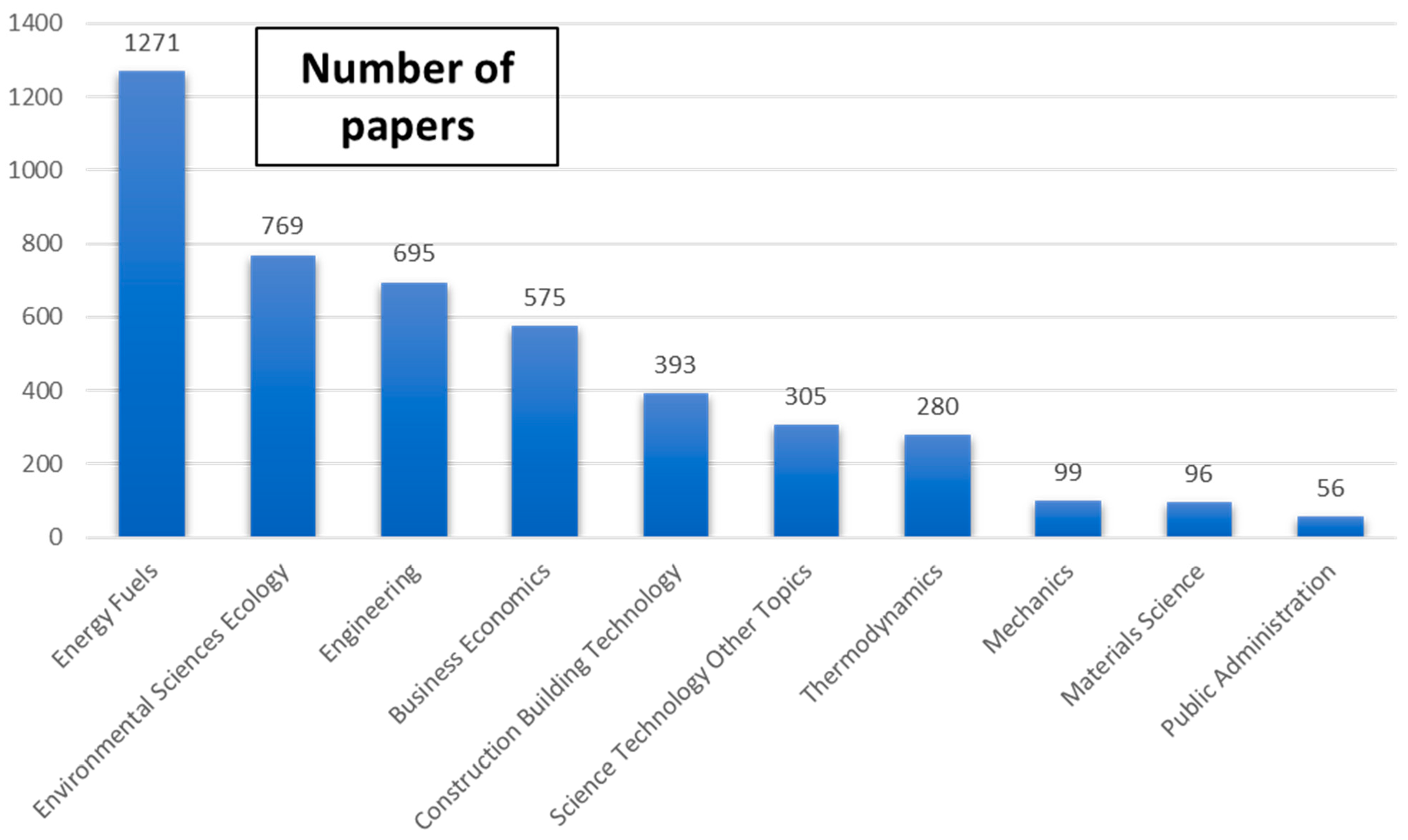

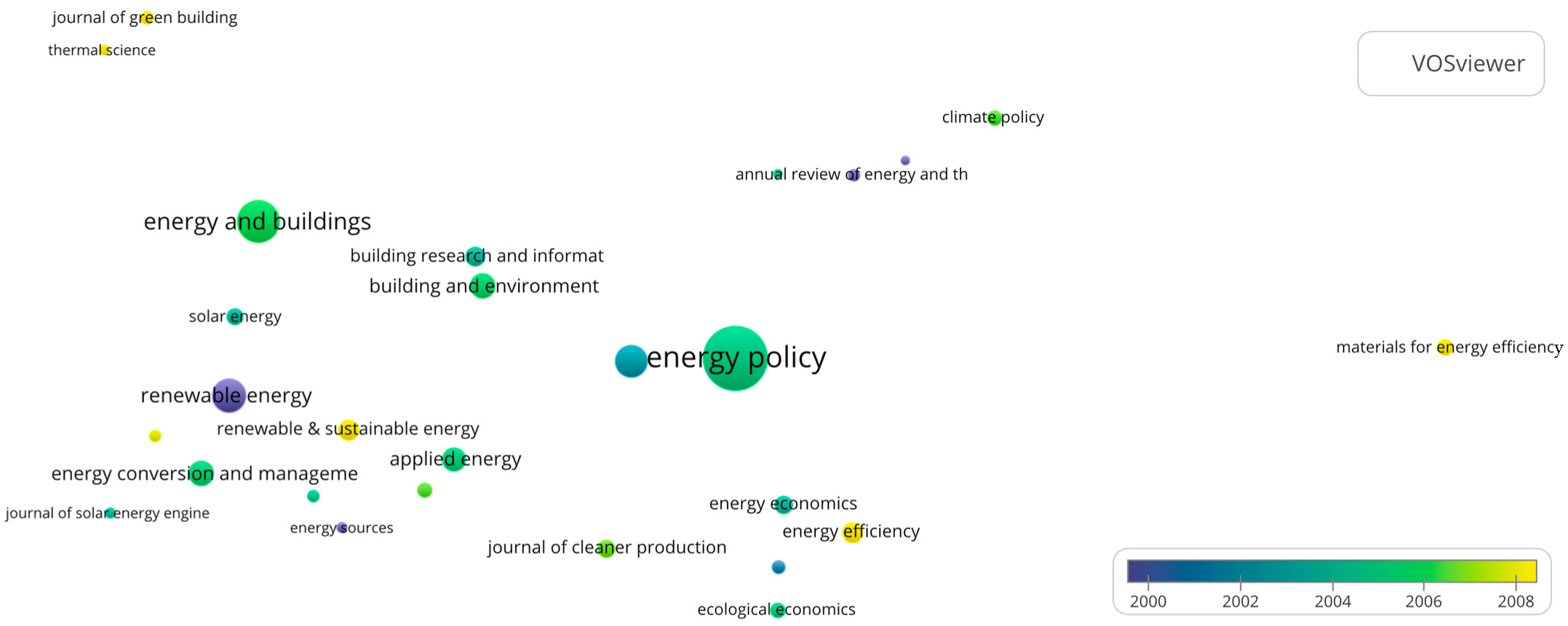
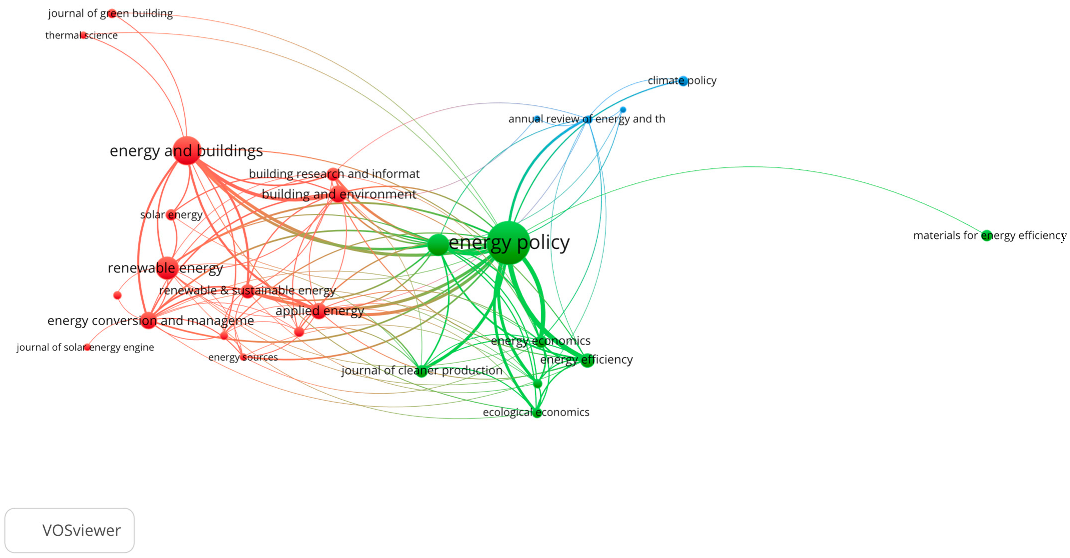
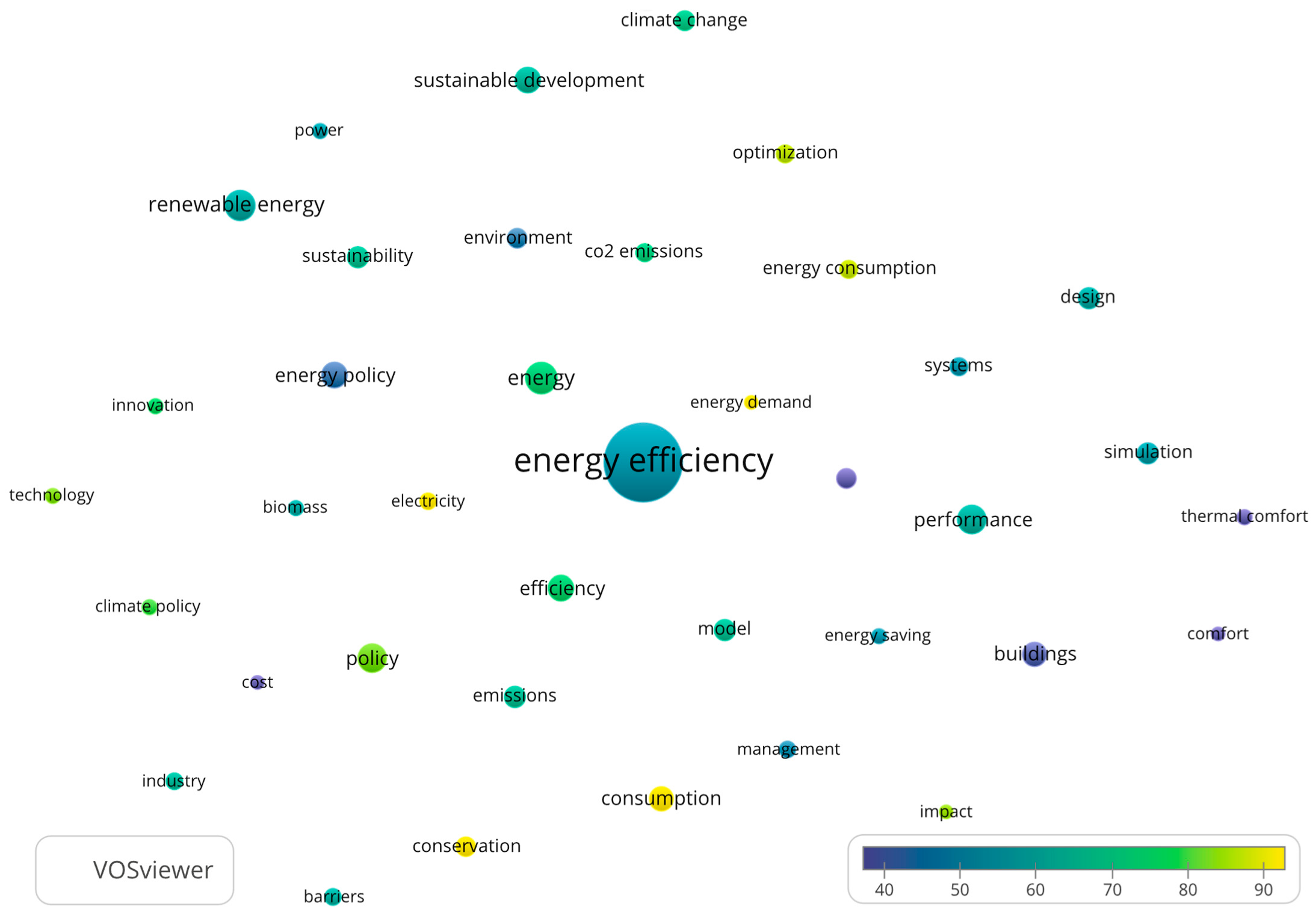
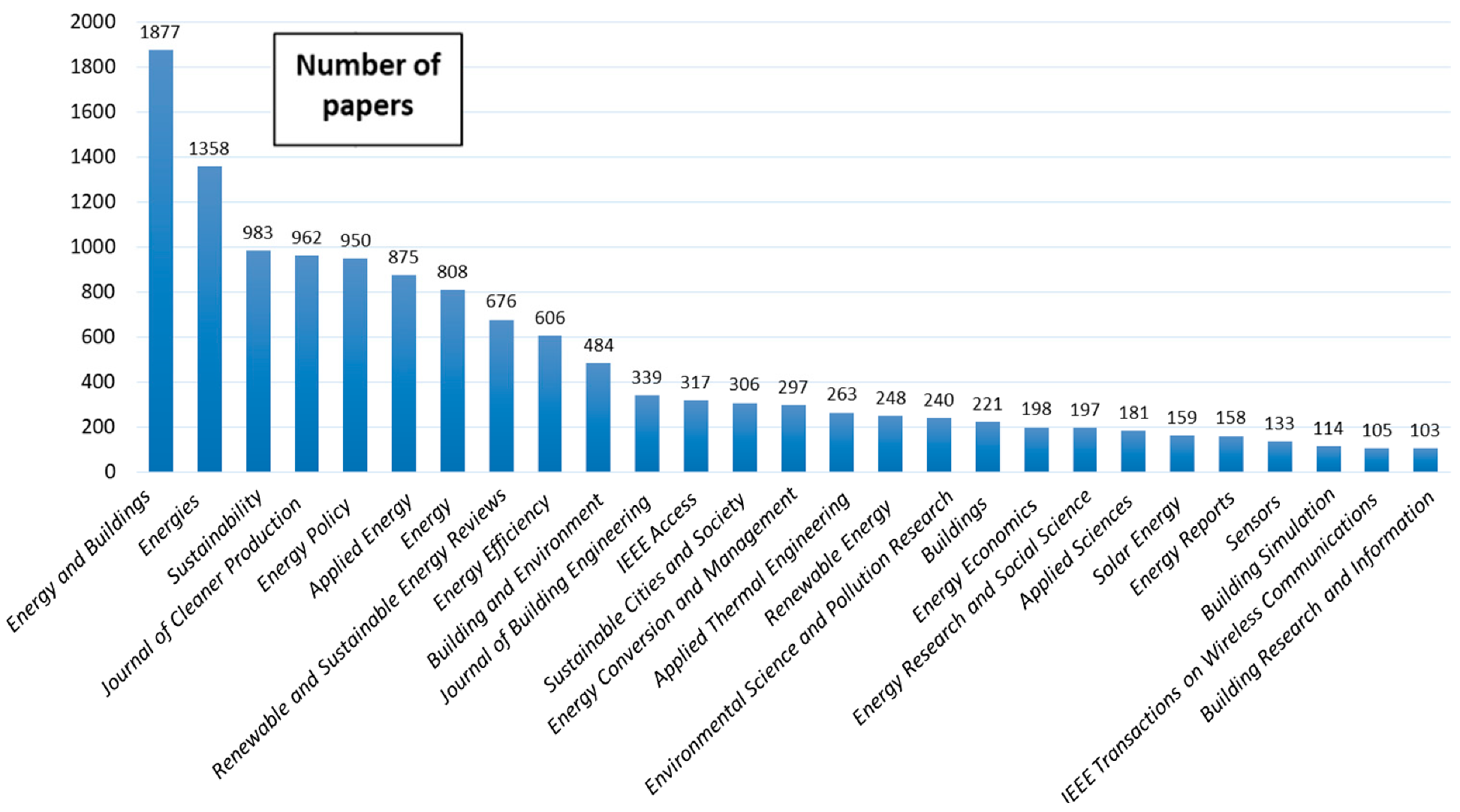
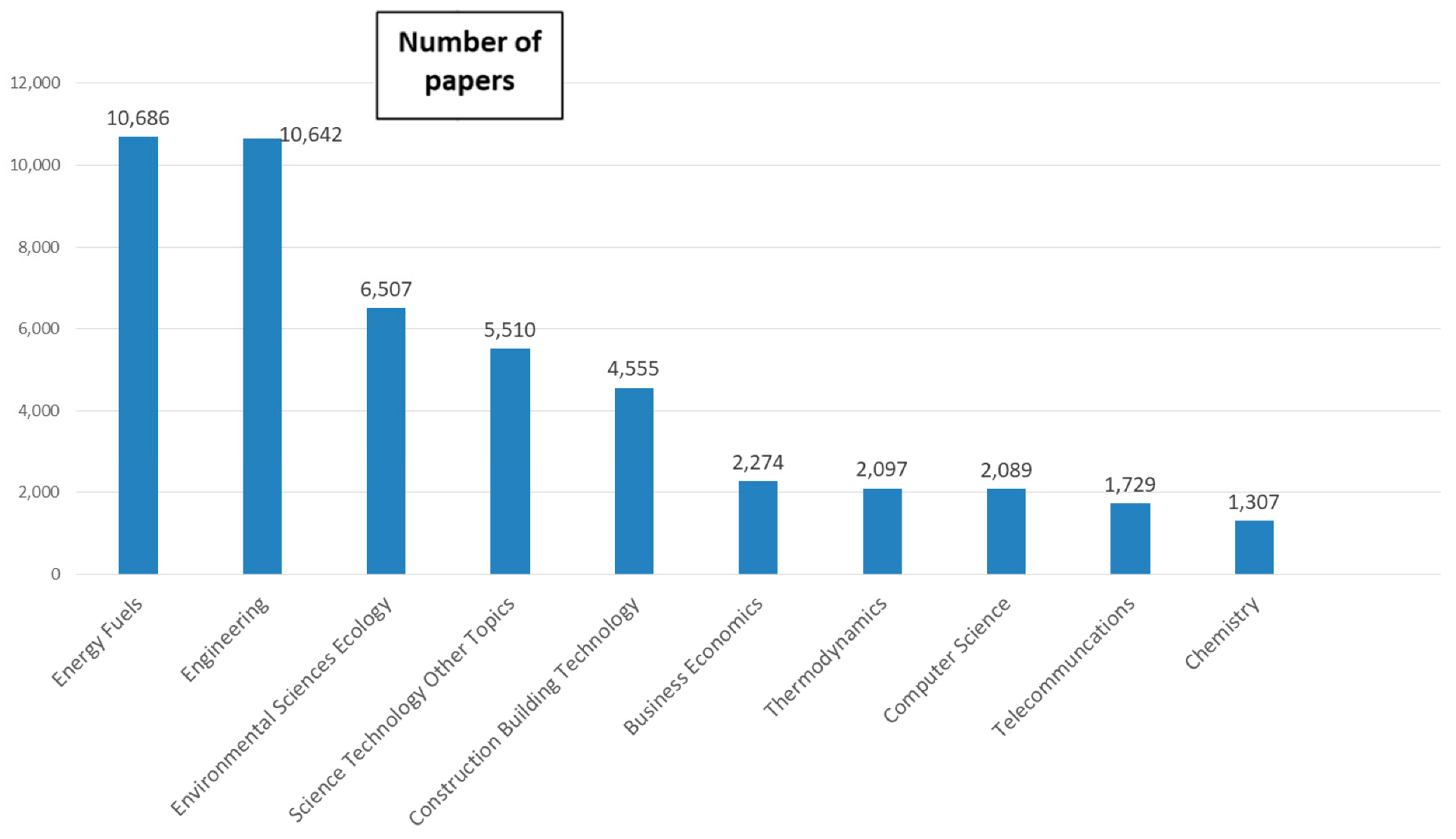
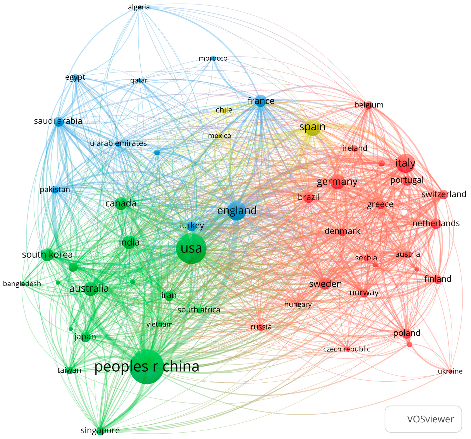

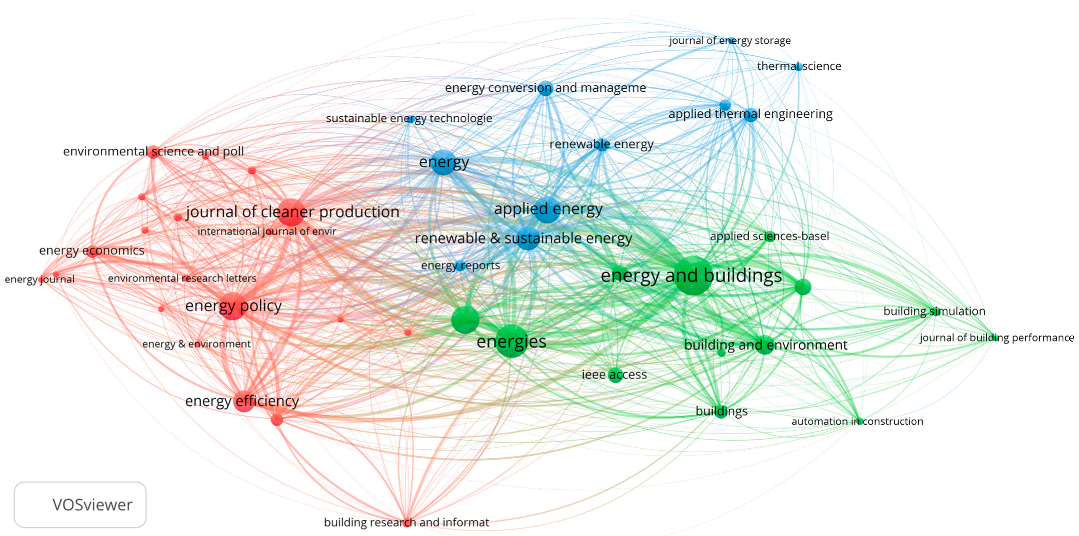
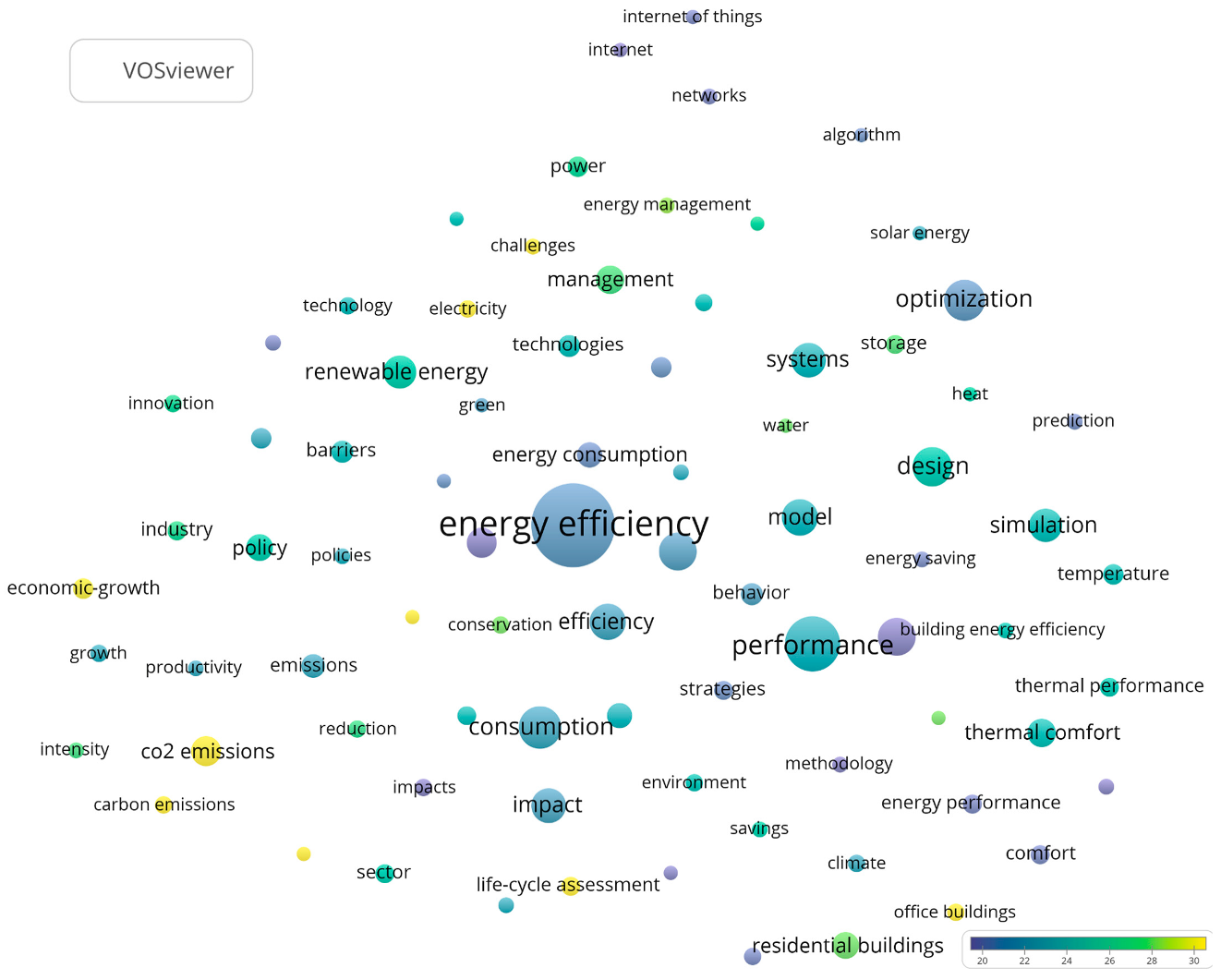

| Country | Papers | Citations | Average Citation/ Manuscript | TLS |
|---|---|---|---|---|
| United States | 518 | 34,422 | 66.45 | 147 |
| China | 223 | 11,457 | 51.38 | 66 |
| England | 213 | 16,142 | 75.78 | 83 |
| Germany | 103 | 7160 | 69.51 | 77 |
| Sweden | 93 | 6416 | 68.99 | 41 |
| Canada | 93 | 9259 | 99.56 | 32 |
| The Netherlands | 90 | 4506 | 50.07 | 47 |
| Italy | 69 | 4227 | 61.26 | 41 |
| France | 66 | 4669 | 70.74 | 51 |
| Source | No. | Citations | Average Citation/ Paper | Impact Factor/2021 | IF without Self-Citations | Publisher |
|---|---|---|---|---|---|---|
| Energy Policy | 415 | 25,146 | 60.59 | 7.576 | 7.014 | Elsevier |
| Energy and Buildings | 179 | 14,259 | 79.66 | 7.201 | 6.147 | Elsevier |
| Renewable Energy | 122 | 1854 | 15.20 | 8.634 | 7.711 | Pergamon-Elsevier |
| Energy | 103 | 4619 | 44.84 | 8.857 | 7.271 | Pergamon-Elsevier |
| Building and Environment | 66 | 3432 | 52.00 | 7.093 | 5.741 | Pergamon-Elsevier |
| Energy Conversion and Management | 66 | 3395 | 51.44 | 11.533 | 9.932 | Pergamon-Elsevier |
| Applied Energy | 55 | 2822 | 51.31 | 11.446 | 10.305 | Elsevier |
| Energy Efficiency | 46 | 2090 | 45.43 | 3.134 | 2.890 | Springer |
| Renewable and Sustainable Energy Reviews | 42 | 6482 | 154.33 | 16.799 | 15.532 | Pergamon-Elsevier |
| Building Research and Information | 41 | 2195 | 60.59 | 4.799 | 4.483 | Routledge Journals, Taylor and Francis Ltd. |
| First Author (Year) | Title | Journal | Impact Factor | Citations | Ref. |
|---|---|---|---|---|---|
| Perez-Lombard (2008) | A review on buildings energy consumption information | Energy and Buildings | 7.201 | 3701 | [30] |
| Ibrahim, H. (2008) | Energy storage systems—Characteristics and comparisons | Renewable and Sustainable Energy Reviews | 16.799 | 1325 | [31] |
| Granqvist, Claes G. (2007) | Transparent conductors as solar energy materials: A panoramic review | Solar Energy Materials and Solar Cells | 7.305 | 1231 | [32] |
| Swan, LG (2009) | Modeling of end-use energy consumption in the residential sector: A review of modeling techniques | Renewable and Sustainable Energy Reviews | 16.799 | 1133 | [33] |
| Greening, LA (2000) | Energy efficiency and consumption—the rebound effect—a survey | Energy Policy | 7.576 | 1125 | [34] |
| Song, CS (2002) | Fuel processing for low-temperature and high-temperature fuel cells—Challenges, and opportunities for sustainable development in the 21st century | Catalysis Today | 6.562 | 950 | [35] |
| Jones, AP (1999) | Indoor air quality and health | Atmospheric Environment | 5.755 | 935 | [36] |
| Omer, AM (2008) | Energy, environment and sustainable development | Renewable and Sustainable Energy Reviews | 16.799 | 922 | [37] |
| Yu, Wenhua (2008) | Review and comparison of nanofluid thermal conductivity and heat transfer enhancements | Heat Transfer Engineering | 2.431 | 858 | [38] |
| Dietz, T | Household actions can provide a behavioral wedge to rapidly reduce US carbon emissions | Proceedings of the National Academy of Sciences of The United States of America | 12.779 | 843 | [39] |
| Organization | Papers | % |
|---|---|---|
| United States Department of Energy (DOE) | 202 | 8.59 |
| Lawrence Berkeley National Laboratory | 137 | 5.82 |
| University of California System | 132 | 5.61 |
| University of California Berkeley | 105 | 4.46 |
| Hong Kong Polytechnic University | 37 | 1.57 |
| Tsinghua University | 31 | 1.32 |
| Swiss Federal Institutes of Technology Domain | 29 | 1.23 |
| Utrecht University | 27 | 1.15 |
| Lund University | 26 | 1.10 |
| Oak Ridge National Laboratory | 26 | 1.10 |
| Chongqing University | 22 | 0.93 |
| City University of Hong Kong | 21 | 0.89 |
| Fraunhofer Gesellschaft | 21 | 0.89 |
| University of Cambridge | 20 | 0.85 |
| Country | Papers | Citations | Average Citation/Manuscript | TLS |
|---|---|---|---|---|
| China | 6126 | 152,483 | 24.89 | 3343 |
| United States | 4792 | 162,762 | 33.97 | 3125 |
| England | 1956 | 60,583 | 30.97 | 2271 |
| Italy | 1867 | 50,175 | 26.87 | 1409 |
| Spain | 1521 | 32,196 | 21.17 | 999 |
| Germany | 1171 | 36,555 | 31.22 | 1461 |
| Australia | 1100 | 29,858 | 27.14 | 1183 |
| India | 995 | 16,805 | 16.89 | 711 |
| South Korea | 866 | 21,408 | 24.72 | 632 |
| Canada | 823 | 27,942 | 33.95 | 943 |
| Source | No. | Citations | Average Citation/Paper | IF/2021 | IF without Self-Citations | Publisher |
|---|---|---|---|---|---|---|
| Energy and Buildings | 1877 | 57,763 | 30.77 | 7.201 | 6.147 | Elsevier |
| Energies | 1358 | 12,176 | 8.97 | 3.252 | 2.466 | MDPI |
| Sustainability | 983 | 8365 | 8.51 | 3.889 | 3.008 | MDPI |
| Journal of Cleaner Production | 962 | 34,286 | 35.64 | 11.072 | 9.707 | Elsevier Sci Ltd. |
| Energy Policy | 950 | 33,101 | 34.84 | 7.576 | 7.014 | Elsevier |
| Applied Energy | 875 | 39,770 | 45.45 | 11.446 | 10.305 | Elsevier |
| Energy | 808 | 24,959 | 30.89 | 8.857 | 7.271 | Pergamon-Elsevier |
| Renewable and Sustainable Energy Reviews | 676 | 39,635 | 58.63 | 16.799 | 15.532 | Pergamon-Elsevier |
| Energy Efficiency | 606 | 7062 | 11.65 | 3.134 | 2.89 | Springer |
| Building and Environment | 484 | 14,828 | 30.64 | 7.093 | 5.741 | Pergamon-Elsevier |
| First Author (Year) | Title | Journal | IF | Citations | Ref. |
|---|---|---|---|---|---|
| Yang, ZG (2011) | Electrochemical Energy Storage for Green Grid | Chemical Reviews | 72.087 | 3600 | [40] |
| Luo, X (2015) | Overview of current development in electrical energy storage technologies and the application potential in power system operation | Applied Energy | 11.446 | 2032 | [41] |
| Palensky, P (2011) | Demand Side Management: Demand Response, Intelligent Energy Systems, and Smart Loads | IEEE Transactions on Industrial Informatics | 11.648 | 1782 | [42] |
| Bocken, NMP (2014) | A literature and practice review to develop sustainable business model archetypes | Journal of Cleaner Production | 11.072 | 1465 | [43] |
| Raman, AP (2014) | Passive radiative cooling below ambient air temperature under direct sunlight | Nature | 69.504 | 1334 | [44] |
| Gielen, D (2019) | The role of renewable energy in the global energy transformation | Energy Strategy Reviews | 10.01 | 1224 | [45] |
| Dincer, I (2015) | Review and evaluation of hydrogen production methods for better sustainability | International Journal of Hydrogen Energy | 7.139 | 1173 | [46] |
| Cabeza, LF (2011) | Materials used as PCM in thermal energy storage in buildings: A review | Renewable and Sustainable Energy Reviews | 16.799 | 1084 | [47] |
| Di Renzo, M (2014) | Spatial Modulation for Generalized MIMO: Challenges, Opportunities, and Implementation | Proceedings of the IEEE | 14.91 | 1030 | [48] |
| Wicklein, B (2015) | Thermally insulating and fire-retardant lightweight anisotropic foams based on nanocellulose and graphene oxide | Nature Nanotechnology | 40.523 | 865 | [49] |
| Organization | Papers | % |
|---|---|---|
| United States Department of Energy (DOE) | 1393 | 5.32 |
| Lawrence Berkeley National Laboratory | 606 | 2.31 |
| University of California System | 576 | 2.20 |
| Tsinghua University | 450 | 1.72 |
| Chinese Academy of Sciences | 411 | 1.57 |
| National Renewable Energy Laboratory USA | 361 | 1.38 |
| University of California Berkeley | 360 | 1.37 |
| University of London | 290 | 1.11 |
| Swiss Federal Institutes of Technology Domain | 264 | 1.01 |
| Udice French Research Universities | 257 | 0.98 |
| Polytechnic University of Milan | 254 | 0.97 |
| Hunan University | 253 | 0.97 |
| Centre National de la Recherche Scientifique (CNRS) | 251 | 0.96 |
| Hong Kong Polytechnic University | 245 | 0.94 |
| Chongqing University | 222 | 0.85 |
| University College London | 221 | 0.84 |
| Aalto University | 206 | 0.79 |
| National University of Singapore | 206 | 0.79 |
| Norwegian University of Science Technology (NTNU) | 202 | 0.77 |
| City University of Hong Kong | 200 | 0.76 |
| Tianjin University | 200 | 0.76 |
Disclaimer/Publisher’s Note: The statements, opinions and data contained in all publications are solely those of the individual author(s) and contributor(s) and not of MDPI and/or the editor(s). MDPI and/or the editor(s) disclaim responsibility for any injury to people or property resulting from any ideas, methods, instructions or products referred to in the content. |
© 2023 by the authors. Licensee MDPI, Basel, Switzerland. This article is an open access article distributed under the terms and conditions of the Creative Commons Attribution (CC BY) license (https://creativecommons.org/licenses/by/4.0/).
Share and Cite
Bungau, C.C.; Hanga Prada, F.I.; Bungau, T.; Bungau, C.; Bendea, G.; Prada, M.F. Web of Science Scientometrics on the Energy Efficiency of Buildings to Support Sustainable Construction Policies. Sustainability 2023, 15, 8772. https://doi.org/10.3390/su15118772
Bungau CC, Hanga Prada FI, Bungau T, Bungau C, Bendea G, Prada MF. Web of Science Scientometrics on the Energy Efficiency of Buildings to Support Sustainable Construction Policies. Sustainability. 2023; 15(11):8772. https://doi.org/10.3390/su15118772
Chicago/Turabian StyleBungau, Constantin C., Francesca Ioana Hanga Prada, Tudor Bungau, Constantin Bungau, Gabriel Bendea, and Marcela Florina Prada. 2023. "Web of Science Scientometrics on the Energy Efficiency of Buildings to Support Sustainable Construction Policies" Sustainability 15, no. 11: 8772. https://doi.org/10.3390/su15118772
APA StyleBungau, C. C., Hanga Prada, F. I., Bungau, T., Bungau, C., Bendea, G., & Prada, M. F. (2023). Web of Science Scientometrics on the Energy Efficiency of Buildings to Support Sustainable Construction Policies. Sustainability, 15(11), 8772. https://doi.org/10.3390/su15118772







